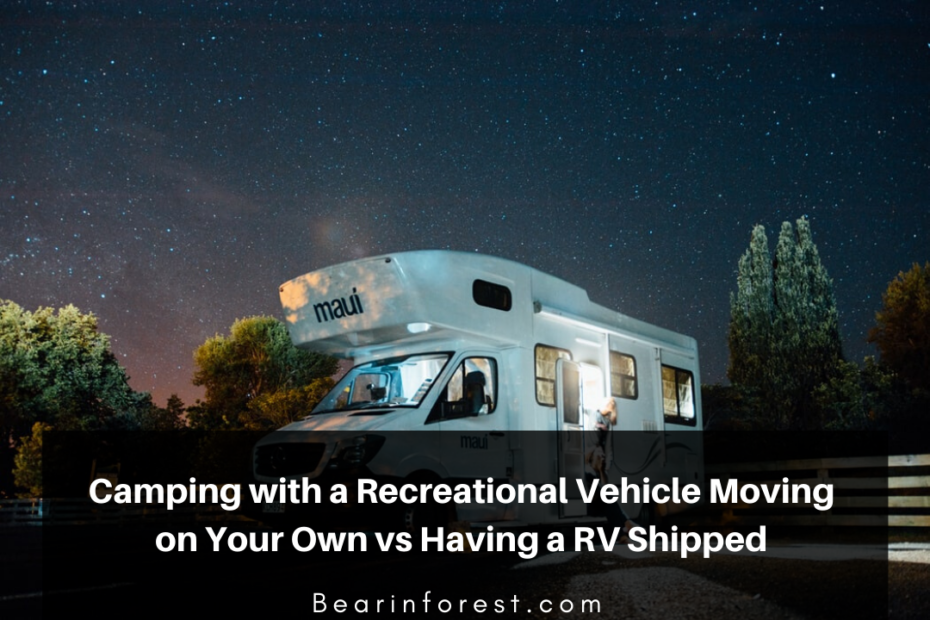The delivery of a recreational vehicle may seem complicated and somewhat ironic. However, sometimes when it is necessary to do it, whether you are moving, selling, or have to drive it to a festival that may be too far from for you to drive it yourself.
Either way, you have the opportunity either to transport it yourself or to get it delivered.
Why use a delivery company? Usually, this requires specialized trucks and equipment. The weight of this extra load affects the gas mileage and often leads to additional costs.
Trying to ship the RV yourself is a challenge; rather, let a professional RV shipping company such as A-1 Auto Transport take care of the process for you.
You can be reassured knowing that the RV carriers you choose from are fully insured and licensed, and will take the full risk and care of the process.
Shipping An RV in the U.S And Alaska
It will be easiest if you are in the United States, working within US borders that cuts off international taxes and customs and the price tag that comes with these things. The price, of course, will depend on how long and heavy your RV is.
It will help the shipper decide how to ship it, whether it will fit on a trailer, or whether other ways will be needed.
It is essential to find out if the company you work with is ready to offer insurance for your RV if something happens to it in the transportation process.
And also to call and ask about specific cases and ask other questions. You should not just trust banners on websites claiming that your vehicle will be insured for $100,000. However, know the facts.
Be aware of how you are going to transport your vehicle. It may be the cheapest option to drive it, but it adds countless miles to your car and wear and tear.

How Do I Ship An RV?
Shipping an RV can be done with the help of a professional shipping company. We recommend choosing a more reputable company. It may seem more expensive, but smaller companies that seem to give you a lower price tend to have more hidden fees at the end of your experience.
Therefore, a little more money in advance tends to allow this experience to be less painful for you in the long run.
You can also transport your RV by train. This way can be cheaper. However, depending on where you are and where you want to deliver it, it may be less convenient.
It also depends on where they deliver it, according to their usual stops, and you will still need to pick it up at the nearest train station.
When you choose the train option, you can choose either an open or closed train to transport it. To better protect it from the weather and possibly vandals at other stops before it gets to you.
How To Get Your RV Ready To Be Shipped
To prepare the vehicle for dispatch, ensure that each door, drawer, and cabinet is closed and taped for safety reasons. Take pictures of everything you can shoot, including photos, mirrors, and more.
Remove any hazardous items from the vehicle, from external fuel to bleach. Anything that can move must also be removed to keep things in your RV while it is moving.
Many companies also have a list of what they want you to do in preparation for transportation. It also includes turning off the anti-theft software during transportation. Prepare your radiator for a new climate, especially if you choose to transport it in a vehicle or train.
Remove all broken items or personal belongings. Make sure you always read the fine print of the company you are working with.

Tips To Prepare Your RV For Transport:
- Remove the entire load - You must remove all items from the van, in most cases, the contents are not covered, and the loss of cargo may cause damage to the interior of the vehicle.
- Make sure everything is securely fastened - including cupboards, doors, windows, and snap-on that are securely fastened, glued, or tied together to prevent damage.
- Remove all hazardous or flammable materials - (propane tanks, gas cans, oil cans, ammunition, or any other potentially dangerous items).
- Turn off any electronics
- Shut off gas
- Turn off the power to your van
- Check the appropriate parts of your RV- (breakdowns, spare tires, steering, etc.), because if something doesn't work, the carrier's insurance won't cover it. You may be charged an extra fee if they have to stop and work on your RV during transport. Tell the RV carrier about any quirks or irregularities that may be found in your RV so that they are aware of them and can adjust the trip accordingly.
- To make sure you haven't forgotten anything, you can hire someone to check your RV before shipping, or you may follow simple steps to check it yourself.
What If My Vehicle Gets Damaged During The Process?
It is what everyone is worried about if the vehicle is to be sent by boat, through the Rockies, or just careless drivers while it is on the road.
The first thing I should do is, of course, be preventative. Get insurance for the RV, check the insurance policy of the company you work with.
How much insurance will they have? What are the ground rules? Also, keep up-to-date photos of your car, so you have something to show when you get it back.
When you get your vehicle back from the carrier, document it again and again with your operator. If you have all the correct documents, you will be more prepared for something to happen. Then contact the company immediately and write it down on its documents.
Most companies try to ensure that you have a good experience with them. If you are going to face the whole struggle to transport your vehicle, you want it to be safe and sound.

What Else Should You Know About RV Transport?
Most drivers will call you 10-24 hours before arrival and disembarkation to clarify all the details of your trip. When the driver arrives, both you and the driver should inspect the RV for any damage, just as you will inspect it when they deliver.
Something else that could be important to you as a customer is how much it will cost to transport your RV. It varies greatly from the shipping company to the shipping company. However, it also depends on the type of RV you are trying to ship and how big your RV is.
Just remember that when you use a suitable transport company, you will be connected to some of the best transport companies in the country that will treat your RV as their own.
To Sum Up
Is it worth transporting an RV or driving yourself is a better option?
That's a question we should all ask ourselves in the end. When it comes to delivering an RV, there are so many logistical as well as financial questions.
However, driving long distances with RV can hurt your true and faithful friend, and it can just be challenging for you and your family.
Enjoy the peace of mind knowing that the RV movers you choose will take the responsibility and worry out of the process rather than you driving on rough roads and putting wear and tear on your RV.
